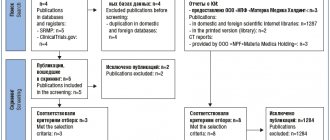- General information
- Why is a cough dangerous during pregnancy?
- Causes and symptoms
- Causes of cough typical for pregnant women
- Treatment of cough in pregnant women
- General recommendations
- Prevention
Pregnant women, due to the stress on the body and a weakened immune system, are more often than others susceptible to acute respiratory viral infections and complications after an illness.
Cough, as a concomitant symptom of colds, is dangerous because it causes contraction of the abdominal, chest and back muscles. The air flow speed during bronchospasm is about 480 km/h. This dynamics leads to uterine tone and the threat of miscarriage. If a pregnant woman is diagnosed with a cough with sputum that is difficult to clear, only a doctor can prescribe a drug for treatment. Most often these are expectorants of plant origin.
Causes of cough in pregnant women
- Inflammation of the respiratory system of a bacterial, viral or fungal nature (tonsillitis, tracheitis, bronchitis, pneumonia, etc.). Infection can lead to complications and threats to the health of the mother and fetus.
- Irritation of the mucous membrane of the upper respiratory tract, exposure to cigarette smoke, dust, other particles and toxic substances in the air.
- Allergic reaction to food, wool, dust, plants and other agents.
- Compression of a certain part of the respiratory organs (for example, enlarged lymph nodes, foreign body, etc.).
- Inhalation of extremely hot or cold air.
- Reflux of acidic contents from the stomach into the esophagus (gastro-esophageal reflux).
- Diseases of the cardiovascular system. A cardiac cough is accompanied by shortness of breath and signs of lack of oxygen (pallor of the skin, blue tint of the mucous membranes and tips of the nails).
- Taking some medications can also cause coughing as a side effect.
Causes and symptoms
The nature of the cough helps the specialist to determine its cause and make a preliminary diagnosis.
- Influenza – a dry cough, mucous discharge sometimes of a purulent color appears after a few days. The cough is accompanied by severe headaches and muscle pain, high fever and general weakness.
- Bronchitis is a sharp spasmodic cough with contraction of the abdominal muscles. A strong cough can trigger the gag reflex. There is pain in the chest area. The cough gets worse in cold or dry air.
- Allergic cough is a problem that pregnant women face due to hormonal changes. Contact with an allergen provokes asthma attacks. The discharge is mucous in nature and practically absent.
- Rhinitis and pharyngitis are accompanied by a dry cough at night. In rare cases, headaches and the area under the eyes hurt.
- Pleurisy - acute chest pain, shortness of breath, high temperature that practically does not go down, frequent dry cough.
- Measles is a debilitating cough and rash on the skin.
Causes of cough typical for pregnant women
- Dryness in the room, which increases the sensitivity of mucous membranes. This leads to an increased urge to cough. This problem is more common during the winter months in heavily heated areas.
- Vasomotor rhinitis during pregnancy is a runny nose caused not by viruses, but by hormonal changes. With a stuffy nose, patients breathe more often through their mouth, which leads to dry mucous membranes, which, in turn, leads to throat irritation.
- Heartburn is a typical complaint. Coughing attacks occur in a lying position, when acid flows from the stomach back into the esophagus, irritating the sensitive mucous membrane of the throat, and then the urge to cough occurs.
- Cardiac cough occurs after excessive physical activity and as a consequence of heart failure. The blood stagnates, swelling forms in the lungs, which irritates the respiratory receptors and provokes a cough.
Dry cough during pregnancy
The dry type of cough is characterized by the absence of sputum. It is often paroxysmal, obsessive, and painful. With a prolonged course of the disease, coughing causes pain in the throat and behind the sternum, spasms and fatigue of the abdominal muscles and respiratory muscles. A strong dry cough interferes with normal breathing, can increase the tone of the uterus and intra-abdominal pressure, cause urinary incontinence with weakness of the pelvic floor muscles, and provoke severe fatigue.
How to reduce a sore throat? What antiseptics can I take?
During pregnancy, it is allowed to use a number of antiseptics for sore throats, so it is not necessary to endure sore throat and other unpleasant symptoms during this period. Medications that expectant mothers can take include:
- ambazon, which has an antimicrobial effect against streptococci, daily dose 4–5 tablets 0.04–0.05 g;
- the combination of lysozyme + pyridoxine exhibits an antiseptic effect against gram-positive and gram-negative bacteria, fungi and viruses. Vitamin B6 in its composition has a protective effect on the oral mucosa. Prescribe 2 tablets 3-4 times a day.
In addition, warm drinks, which are indicated in unlimited but reasonable quantities, help reduce sore throat.
Cough with phlegm during pregnancy
With a wet cough, sputum is released: it is distinguished by volume, consistency, thickness and color. Cough with sputum is more typical for diseases of the lower respiratory tract (bronchitis, pneumonia). With a productive cough, sputum is actively expectorated in large quantities. An unproductive cough is more often observed in the first days of infectious diseases in the form of a small amount of viscous discharge, or is of allergic origin.
General recommendations
- The air humidity in the room should be 65-70%. This level of humidity is comfortable for the body, prevents the mucous membrane from drying out, and reduces the rate of development of pathogens. Wet cleaning reduces the risk of contact with allergens (pollen, dust, pet hair).
- The room must be ventilated regularly, at least 2 times a day. Fresh air reduces the concentration of the virus in the air. It is recommended to maintain the room temperature at 22 degrees.
- It is necessary to drink enough fluid to liquefy the mucus naturally.
- Bed rest, especially in the first 3-4 days after the first symptoms appear.
How to treat cough during pregnancy
Recommendations for treating cough will depend on the cause of the symptom. If the cause is exposure to chemicals, cigarette smoke, or allergic agents, then the first step should be to reduce or completely stop their effect on the expectant mother’s body. If the disease is infectious, in addition to symptomatic treatment, antibacterial or antiviral drugs may be required.
It should be remembered that not all medications are approved for use during pregnancy, especially in the first trimester. Your doctor will choose the most effective and safe treatment.
In the first trimester
If you have a cough in early pregnancy, it is better to opt for gargling with a saline solution and drinking plenty of liquid. It is allowed to take Mucaltin and Libexin tablets if indicated. Among the physiotherapeutic procedures, inhalation with Borjomi mineral water or 0.5-2% sodium bicarbonate solution and drainage massage will have a positive effect.
is prohibited due to a lack of clinical studies and a possible negative effect on fetal development.
In the second and third trimester
To relieve dry cough and improve the removal of sputum when wet, it is recommended to take mucolytics and expectorants. All medicines and herbal preparations require caution if there is a tendency to allergic reactions of any severity. Semi-synthetic drugs are allowed in the 2nd and 3rd trimester, provided that their benefit significantly outweighs the possible harm - this is determined by the doctor. Ambroxol preparations can also be prescribed to stimulate fetal lung development.
Cough tablets that affect the respiratory center (Codeine, Solpadeine, etc.) are strictly prohibited
Prevention
- It is not recommended to visit crowded places, especially during seasonal flu epidemics.
- Contact with sick people should be limited.
- On a regular basis, it is necessary to use products to moisturize the nasal mucosa.
- After visiting public places, it is important to thoroughly clean your hands with antibacterial agents.
- It is necessary to wear a gauze bandage when visiting medical institutions and public institutions.
- You should only use personal household appliances and hygiene products to prevent the transmission of germs through household means.
Bromhexine during pregnancy
The effectiveness of bromhexine in bronchopulmonary diseases is determined by its mucolytic and secretomotor actions. It helps to liquefy sputum and can relieve a dry cough or improve the evacuation of thick and purulent discharge during a wet cough. Improving the mobility of the cilia of the epithelium lining the lower respiratory tract will speed up the removal of stagnant mucus, promoting rapid recovery.
Bromhexine: instructions for use
This medicine is approved for use from the 2nd and 3rd trimester only on medical advice. An important role is played by the release form (tablets, syrup, solution, etc.) and the manufacturer. The list of chemicals included in the drug, in addition to the main active component bromhexine hydrochloride, will depend on them. Less preferable for pregnant women are syrups that contain sweeteners, dyes, flavors and require a high daily dose.
Bromhexine is excreted in breast milk and is therefore not recommended for use by nursing women. Consultation with your physician is required before use.
Breathing with turbulence and friction
Chief, I can hear you
Bronchial breathing is a sound phenomenon that occurs when air turbulence passes through the larynx, and is also the site of the division of the trachea into two main bronchi (tracheal bifurcation). Since zones of turbulence occur both during inhalation and exhalation, bronchial breathing is clearly audible both in the first phase of breathing and in the second.
You've probably noticed that the doctor doesn't listen to the lungs at one point, but strives to poke the stethoscope all over the back, and in young beautiful girls he listens especially intently to the lungs in front. In general, he is not doing this out of a good life, believe me. Our lungs are rather large, and the doctor needs to determine whether the noise is heard over their entire surface or whether it is localized. Is one type of breathing heard everywhere, or is there an alternative somewhere?
A striking example of such an alternative is bronchial breathing. As we have already said, normally vesicular breathing should be heard over the entire surface of the lungs. Let me clarify: almost all of it. Above the larynx, in the projection of the trachea and especially in the projection of its bifurcation - the level of the IV-V thoracic vertebrae (in young beautiful girls - this is right at the very top of the cleavage;)) bronchial breathing is normally heard. Sometimes, to distinguish it from pathological bronchial breathing, it is called laryngo-tracheal breathing. That is, the laryngo-tracheal is somehow the norm, but the bronchial is no longer the norm.
Let me emphasize once again that normally bronchial breathing should not be heard over other parts of the lungs. If it appears somewhere else, it means there is a problem in the lungs. Most often, associated with compaction of the lung tissue (under such conditions, sounds are conducted much better than through air lungs).
Depending on the severity of the process, bronchial breathing may overlap with vesicular breathing, or may completely displace it. What can cause hardening of lung tissue? Pneumonia, first of all. Especially massive, lobar, for example.
In addition to pneumonia, compaction of lung tissue can cause tuberculosis, pulmonary infarction, compression atelectasis of the lung (collapse of lung tissue and compression of the lung to its root), pneumosclerosis (when lung tissue is replaced by connective tissue).
To be fair, it should be noted that bronchial breathing can rarely be heard over the entire surface of the lungs. Most often, it is perfectly audible above the source of compaction, and if you move to the side, its volume drops exponentially. This fact helps the doctor to say with a certain degree of probability where exactly the problem is located.
Amphoric breathing is also a variant of pathological bronchial breathing. It can be heard if a cavity in the lung (5-6 cm in diameter, usually smooth-walled) connects to a bronchus. A cavity can appear, for example, with a lung abscess.
Essentially, we get the Pan Flute element. The air passes over the opening of the cavity - and we hear a fairly loud and somewhat musical sound.
The old professors mentioned more than once suggested taking an empty champagne bottle and blowing over its neck. The sound is almost the same as with amphoric breathing.
It's cold!
Fortunately, quite rarely, there are disturbances in the innervation of the respiratory muscles. With such a pathology, they do not all work at the same time, but one by one, step by step. As a result, we get a stepped inhalation. Our exhalation is passive, muscles are not particularly needed there, so the second phase of breathing is usually not changed.
This type of breathing is called saccoded.
But in the overwhelming majority of cases, saccoded breathing is explained by completely normal and not at all pathological reasons. First of all, the cold. It’s good for the doctor, under his coat he may have not only a fiery heart, but also, for example, a woolen vest. But the patient has no choice, he has to be naked to the waist (from above), even if it is not hot in the office or ward, to put it mildly. The muscles begin to engage in tremulous thermogenesis, resulting in saccoded breathing upon auscultation.
Therefore, it is recommended to examine patients in a more or less warm room. And warm the head of the phonendoscope in your hands before applying it to the patient’s skin. For experienced therapists, this is already at the level of automation: you interview a person, and the stethoscope warms up in your hand.
Another option is people who, when they see a doctor, begin to get terribly worried. And again we hear saccoded breathing. Again, if the patient sobs before the doctor arrives, then for some time he will again experience saccoded breathing. And again, the reason is not illness at all, it’s just the consequences of crying.
Well, to figure out whether it is a violation of the innervation of the respiratory muscles or recent crying - this is precisely the art of the diagnostician.
Noise maker mouse
And now we move on to the most notable noisemaker in the lung area. As you know, our lungs are covered with a kind of elastic film - pleura. And the chest cavity is lined from the inside with the same pleura. Between these two layers there is a small cavity, which is called the pleural cavity. Both leaves are coated with a small amount of lubricant to facilitate breathing movements.
If the pathological process is localized not in the depths of the lungs, but on the surface, the pleura covering the lungs can also become inflamed. In this case, the lubrication can either disappear (as with the rapid loss of a noticeable amount of fluid by the body - cholera, blood loss, indomitable
vomiting and other delights), or fibrin may be deposited on the surface of the pleura, adhesions and scars may occur (tuberculosis, cancer, etc.).
As a result, the sliding of the pleura becomes no longer so easy and carefree. And not so silent.
Pleural friction noise is one of the loudest sound phenomena. Already annoying, the old professors compared it to the crunch of snow on a frosty day. Amazingly accurate definition.
Distinctive features - does not disappear when coughing, is clearly audible both on inhalation and exhalation, if you press with the head of the phonendoscope, the pleural friction noise will intensify. Thus, it can be distinguished from fine moist rales and crepitus. There is another sadistic technique: cover the patient’s mouth and nose and ask him to imitate breathing movements with his stomach, perhaps accompanied by music. The pleural friction noise will remain, but there will be no wheezing or crepitus. The main thing with this technique is to quickly run away after it is completed.
Most often, pleural friction noise is heard in places of greatest amplitude of respiratory movements, that is, from below on the sides. Much less often (with tuberculosis) it can be detected in the area of the apexes of the lungs
What can a pregnant woman take for a debilitating dry cough?
Antitussive drugs, like mucolytics, are prohibited from taking during pregnancy at all or are allowed under the supervision of a doctor after assessing the risks and benefits. Thus, the popular centrally acting antitussive drug butamirate can be taken only in the second and third trimesters and only after consultation with a doctor. The peripheral drug prenoxdiazine is also used with caution during pregnancy. Thus, when counseling a pregnant woman with a dry cough, she should be advised to immediately visit a doctor.









